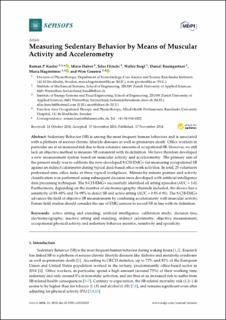Please use this identifier to cite or link to this item:
https://doi.org/10.21256/zhaw-2789| Publication type: | Article in scientific journal |
| Type of review: | Peer review (publication) |
| Title: | Measuring sedentary behavior by means of muscular activity and accelerometry |
| Authors: | Kuster, Roman Huber, Mirco Hirschi, Silas Siegl, Walter Baumgartner, Daniel Hagströmer, Maria Grooten, Wim |
| DOI: | 10.21256/zhaw-2789 10.3390/s18114010 |
| Published in: | Sensors |
| Volume(Issue): | 18 |
| Issue: | 11 |
| Issue Date: | 2018 |
| Publisher / Ed. Institution: | MDPI |
| ISSN: | 1424-8220 1424-8239 |
| Language: | English |
| Subjects: | Active sitting and standing; Artificial intelligence; Calibration study; Decision tree; Electromyography; Inactive sitting and standing; Indirect calorimetry; Objective measurement; Occupational physical activity and sedentary behavior monitor; Ssensitivity and specificity; Accelerometry; Electromyography; Posture; Workplace; Sedentary behavior |
| Subject (DDC): | 610: Medicine and health |
| Abstract: | Sedentary Behavior (SB) is among the most frequent human behaviors and is associated with a plethora of serious chronic lifestyle diseases as well as premature death. Office workers in particular are at an increased risk due to their extensive amounts of occupational SB. However, we still lack an objective method to measure SB consistent with its definition. We have therefore developed a new measurement system based on muscular activity and accelerometry. The primary aim of the present study was to calibrate the new-developed 8-CH-EMG+ for measuring occupational SB against an indirect calorimeter during typical desk-based office work activities. In total, 25 volunteers performed nine office tasks at three typical workplaces. Minute-by-minute posture and activity classification was performed using subsequent decision trees developed with artificial intelligence data processing techniques. The 8-CH-EMG+ successfully identified all sitting episodes (AUC = 1.0). Furthermore, depending on the number of electromyography channels included, the device has a sensitivity of 83-98% and 74-98% to detect SB and active sitting (AUC = 0.85-0.91). The 8-CH-EMG+ advances the field of objective SB measurements by combining accelerometry with muscular activity. Future field studies should consider the use of EMG sensors to record SB in line with its definition. |
| Further description: | Article 4010 |
| URI: | https://digitalcollection.zhaw.ch/handle/11475/16059 |
| Fulltext version: | Published version |
| License (according to publishing contract): | CC BY 4.0: Attribution 4.0 International |
| Departement: | School of Engineering |
| Organisational Unit: | Institute of Mechanical Systems (IMES) |
| Appears in collections: | Publikationen School of Engineering |
Files in This Item:
| File | Description | Size | Format | |
|---|---|---|---|---|
| 2018_Kuster_Measuring Sendentary Behavior_Sensors.pdf | 785 kB | Adobe PDF |  View/Open |
Show full item record
Kuster, R., Huber, M., Hirschi, S., Siegl, W., Baumgartner, D., Hagströmer, M., & Grooten, W. (2018). Measuring sedentary behavior by means of muscular activity and accelerometry. Sensors, 18(11). https://doi.org/10.21256/zhaw-2789
Kuster, R. et al. (2018) ‘Measuring sedentary behavior by means of muscular activity and accelerometry’, Sensors, 18(11). Available at: https://doi.org/10.21256/zhaw-2789.
R. Kuster et al., “Measuring sedentary behavior by means of muscular activity and accelerometry,” Sensors, vol. 18, no. 11, 2018, doi: 10.21256/zhaw-2789.
KUSTER, Roman, Mirco HUBER, Silas HIRSCHI, Walter SIEGL, Daniel BAUMGARTNER, Maria HAGSTRÖMER und Wim GROOTEN, 2018. Measuring sedentary behavior by means of muscular activity and accelerometry. Sensors. 2018. Bd. 18, Nr. 11. DOI 10.21256/zhaw-2789
Kuster, Roman, Mirco Huber, Silas Hirschi, Walter Siegl, Daniel Baumgartner, Maria Hagströmer, and Wim Grooten. 2018. “Measuring Sedentary Behavior by Means of Muscular Activity and Accelerometry.” Sensors 18 (11). https://doi.org/10.21256/zhaw-2789.
Kuster, Roman, et al. “Measuring Sedentary Behavior by Means of Muscular Activity and Accelerometry.” Sensors, vol. 18, no. 11, 2018, https://doi.org/10.21256/zhaw-2789.
Items in DSpace are protected by copyright, with all rights reserved, unless otherwise indicated.